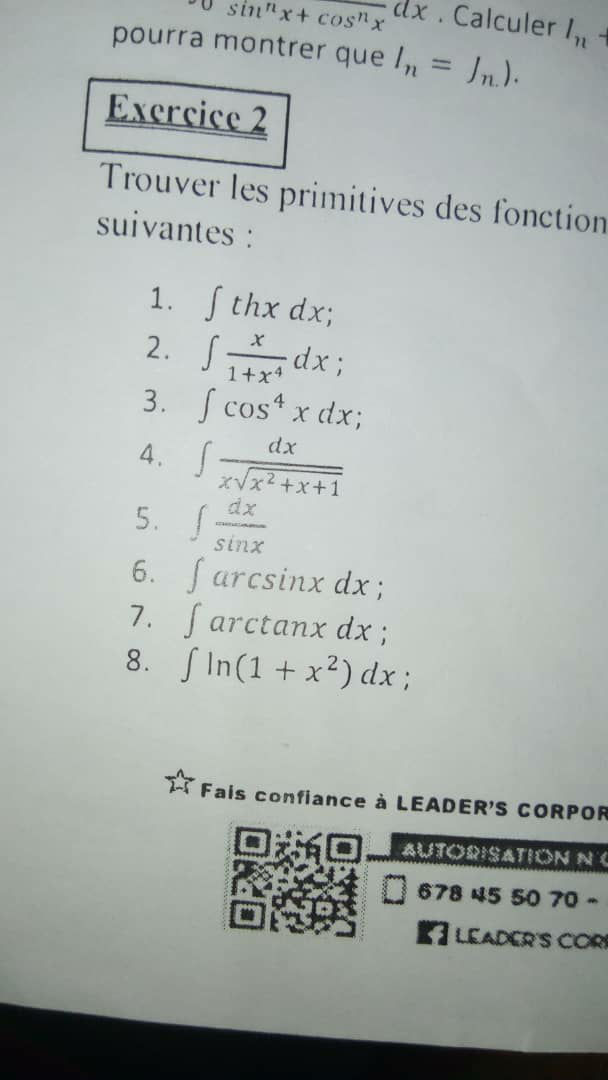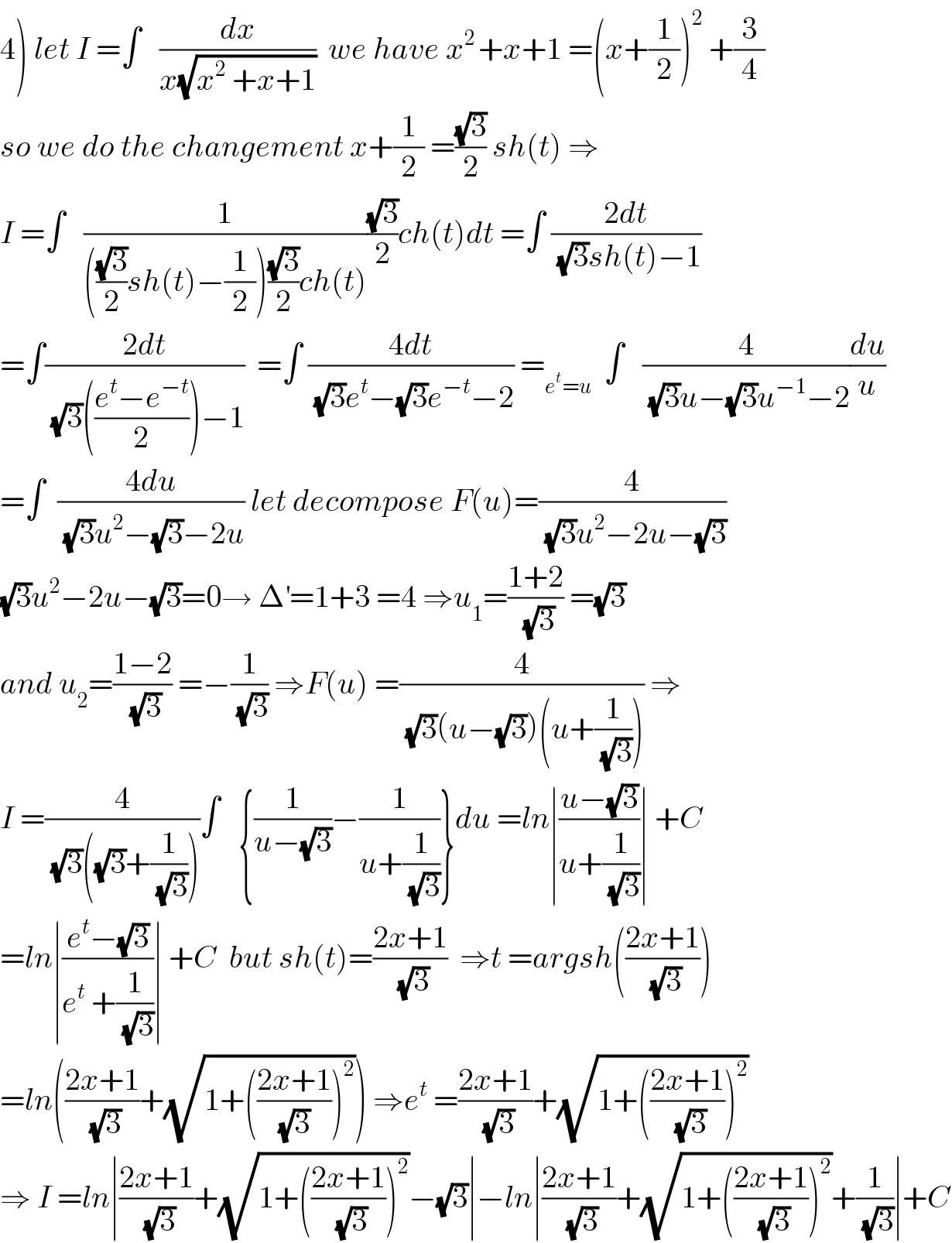Question Number 66938 by Cmr 237 last updated on 20/Aug/19

Commented by mathmax by abdo last updated on 21/Aug/19

$$\left.\mathrm{8}\right){by}\:{parts}\:\:\int\:{ln}\left(\mathrm{1}+{x}^{\mathrm{2}} \right){dx}\:={xln}\left(\mathrm{1}+{x}^{\mathrm{2}} \right)−\int\:{x}\frac{\mathrm{2}{x}}{\mathrm{1}+{x}^{\mathrm{2}} }{dx} \\ $$$$={xln}\left(\mathrm{1}+{x}^{\mathrm{2}} \right)−\mathrm{2}\:\int\:\:\frac{\mathrm{1}+{x}^{\mathrm{2}} −\mathrm{1}}{\mathrm{1}+{x}^{\mathrm{2}} }{dx}\:={xln}\left(\mathrm{1}+{x}^{\mathrm{2}} \right)−\mathrm{2}{x}\:+\mathrm{2}\:{arctanx}\:+{C} \\ $$$$\left.\mathrm{7}\right)\:{by}\:{parts}\:\int\:{arctanx}\:{dx}\:={x}\:{arctan}\left({x}\right)−\int\:\frac{{x}}{\mathrm{1}+{x}^{\mathrm{2}} }{dx} \\ $$$$={x}\:{arctan}\left({x}\right)−\frac{\mathrm{1}}{\mathrm{2}}{ln}\left(\mathrm{1}+{x}^{\mathrm{2}} \right)\:+{C} \\ $$
Commented by mathmax by abdo last updated on 21/Aug/19

$$\left.\mathrm{6}\right)\:{we}\:{do}\:{the}\:{changement}\:{arcsinx}\:={t}\:\Rightarrow{x}={sint}\:\Rightarrow \\ $$$$\int\:{arcsinx}\:{dx}\:=\int\:{t}\:{cost}\:{dt}\:=_{{by}\:{parts}} \:\:{tsint}\:−\int\:{sint}\:{dt} \\ $$$$={tsint}\:+{cost}\:\:+{C}\:={x}\:{arcsinx}\:+\sqrt{\mathrm{1}−{x}^{\mathrm{2}} }\:+{C}\:. \\ $$
Commented by mathmax by abdo last updated on 21/Aug/19

$$\left.\mathrm{5}\right)\:{we}\:{do}\:{the}\:{changement}\:{tan}\left(\frac{{x}}{\mathrm{2}}\right)={t}\:\Rightarrow \\ $$$$\int\:\frac{{dx}}{{sinx}}\:=\int\:\:\:\frac{\mathrm{1}}{\frac{\mathrm{2}{t}}{\mathrm{1}+{t}^{\mathrm{2}} }}\frac{\mathrm{2}{dt}}{\mathrm{1}+{t}^{\mathrm{2}} }=\:\int\:\frac{{dt}}{{t}}\:={ln}\mid{t}\mid\:+{C}\:={ln}\mid{tan}\left(\frac{{x}}{\mathrm{2}}\right)\mid\:+{C} \\ $$
Commented by mathmax by abdo last updated on 21/Aug/19

$$\left.\mathrm{4}\right)\:{let}\:{I}\:=\int\:\:\:\frac{{dx}}{{x}\sqrt{{x}^{\mathrm{2}} \:+{x}+\mathrm{1}}}\:\:{we}\:{have}\:{x}^{\mathrm{2}\:} +{x}+\mathrm{1}\:=\left({x}+\frac{\mathrm{1}}{\mathrm{2}}\right)^{\mathrm{2}} \:+\frac{\mathrm{3}}{\mathrm{4}} \\ $$$${so}\:{we}\:{do}\:{the}\:{changement}\:{x}+\frac{\mathrm{1}}{\mathrm{2}}\:=\frac{\sqrt{\mathrm{3}}}{\mathrm{2}}\:{sh}\left({t}\right)\:\Rightarrow \\ $$$${I}\:=\int\:\:\:\frac{\mathrm{1}}{\left(\frac{\sqrt{\mathrm{3}}}{\mathrm{2}}{sh}\left({t}\right)−\frac{\mathrm{1}}{\mathrm{2}}\right)\frac{\sqrt{\mathrm{3}}}{\mathrm{2}}{ch}\left({t}\right)}\frac{\sqrt{\mathrm{3}}}{\mathrm{2}}{ch}\left({t}\right){dt}\:=\int\:\frac{\mathrm{2}{dt}}{\:\sqrt{\mathrm{3}}{sh}\left({t}\right)−\mathrm{1}} \\ $$$$=\int\frac{\mathrm{2}{dt}}{\:\sqrt{\mathrm{3}}\left(\frac{{e}^{{t}} −{e}^{−{t}} }{\mathrm{2}}\right)−\mathrm{1}}\:\:=\int\:\frac{\mathrm{4}{dt}}{\:\sqrt{\mathrm{3}}{e}^{{t}} −\sqrt{\mathrm{3}}{e}^{−{t}} −\mathrm{2}}\:=_{{e}^{{t}} ={u}} \:\:\int\:\:\:\frac{\mathrm{4}}{\:\sqrt{\mathrm{3}}{u}−\sqrt{\mathrm{3}}{u}^{−\mathrm{1}} −\mathrm{2}}\frac{{du}}{{u}} \\ $$$$=\int\:\:\frac{\mathrm{4}{du}}{\:\sqrt{\mathrm{3}}{u}^{\mathrm{2}} −\sqrt{\mathrm{3}}−\mathrm{2}{u}}\:{let}\:{decompose}\:{F}\left({u}\right)=\frac{\mathrm{4}}{\:\sqrt{\mathrm{3}}{u}^{\mathrm{2}} −\mathrm{2}{u}−\sqrt{\mathrm{3}}} \\ $$$$\sqrt{\mathrm{3}}{u}^{\mathrm{2}} −\mathrm{2}{u}−\sqrt{\mathrm{3}}=\mathrm{0}\rightarrow\:\Delta^{'} =\mathrm{1}+\mathrm{3}\:=\mathrm{4}\:\Rightarrow{u}_{\mathrm{1}} =\frac{\mathrm{1}+\mathrm{2}}{\:\sqrt{\mathrm{3}}}\:=\sqrt{\mathrm{3}} \\ $$$${and}\:{u}_{\mathrm{2}} =\frac{\mathrm{1}−\mathrm{2}}{\:\sqrt{\mathrm{3}}}\:=−\frac{\mathrm{1}}{\:\sqrt{\mathrm{3}}}\:\Rightarrow{F}\left({u}\right)\:=\frac{\mathrm{4}}{\:\sqrt{\mathrm{3}}\left({u}−\sqrt{\mathrm{3}}\right)\left({u}+\frac{\mathrm{1}}{\:\sqrt{\mathrm{3}}}\right)}\:\Rightarrow \\ $$$${I}\:=\frac{\mathrm{4}}{\:\sqrt{\mathrm{3}}\left(\sqrt{\mathrm{3}}+\frac{\mathrm{1}}{\:\sqrt{\mathrm{3}}}\right)}\int\:\:\:\left\{\frac{\mathrm{1}}{{u}−\sqrt{\mathrm{3}}}−\frac{\mathrm{1}}{{u}+\frac{\mathrm{1}}{\:\sqrt{\mathrm{3}}}}\right\}{du}\:={ln}\mid\frac{{u}−\sqrt{\mathrm{3}}}{{u}+\frac{\mathrm{1}}{\:\sqrt{\mathrm{3}}}}\mid\:+{C} \\ $$$$={ln}\mid\frac{{e}^{{t}} −\sqrt{\mathrm{3}}}{{e}^{{t}} \:+\frac{\mathrm{1}}{\:\sqrt{\mathrm{3}}}}\mid\:+{C}\:\:{but}\:{sh}\left({t}\right)=\frac{\mathrm{2}{x}+\mathrm{1}}{\:\sqrt{\mathrm{3}}}\:\:\Rightarrow{t}\:={argsh}\left(\frac{\mathrm{2}{x}+\mathrm{1}}{\:\sqrt{\mathrm{3}}}\right) \\ $$$$={ln}\left(\frac{\mathrm{2}{x}+\mathrm{1}}{\:\sqrt{\mathrm{3}}}+\sqrt{\mathrm{1}+\left(\frac{\mathrm{2}{x}+\mathrm{1}}{\:\sqrt{\mathrm{3}}\:}\right)^{\mathrm{2}} }\right)\:\Rightarrow{e}^{{t}} \:=\frac{\mathrm{2}{x}+\mathrm{1}}{\:\sqrt{\mathrm{3}}}+\sqrt{\mathrm{1}+\left(\frac{\mathrm{2}{x}+\mathrm{1}}{\:\sqrt{\mathrm{3}}}\right)^{\mathrm{2}} } \\ $$$$\Rightarrow\:{I}\:={ln}\mid\frac{\mathrm{2}{x}+\mathrm{1}}{\:\sqrt{\mathrm{3}}}+\sqrt{\mathrm{1}+\left(\frac{\mathrm{2}{x}+\mathrm{1}}{\:\sqrt{\mathrm{3}}}\right)^{\mathrm{2}} }−\sqrt{\mathrm{3}}\mid−{ln}\mid\frac{\mathrm{2}{x}+\mathrm{1}}{\:\sqrt{\mathrm{3}}}+\sqrt{\mathrm{1}+\left(\frac{\mathrm{2}{x}+\mathrm{1}}{\:\sqrt{\mathrm{3}}}\right)^{\mathrm{2}} }+\frac{\mathrm{1}}{\:\sqrt{\mathrm{3}}}\mid+{C} \\ $$
Commented by Cmr 237 last updated on 21/Aug/19

$$\mathrm{thank}\:\mathrm{sir}\:\left(\mathrm{merci}\:\mathrm{beaucoup}\:\mathrm{monsieur}\right) \\ $$
Commented by mathmax by abdo last updated on 21/Aug/19

$${you}\:{are}\:{welcome}\:{sir}. \\ $$
Commented by mathmax by abdo last updated on 22/Aug/19

$$\left.\mathrm{3}\right)\int\:{cos}^{\mathrm{4}} {xdx}\:=\int\:\:\left(\frac{\mathrm{1}+{cos}\left(\mathrm{2}{x}\right)}{\mathrm{2}}\right)^{\mathrm{2}} {dx}\:=\frac{\mathrm{1}}{\mathrm{4}}\int\left(\mathrm{1}+\mathrm{2}{cos}\left(\mathrm{2}{x}\right)+{cos}^{\mathrm{2}} \left(\mathrm{2}{x}\right)\right){dx} \\ $$$$=\frac{\mathrm{1}}{\mathrm{4}}{x}\:+\frac{\mathrm{1}}{\mathrm{2}}\int{cos}\left(\mathrm{2}{x}\right){dx}\:+\frac{\mathrm{1}}{\mathrm{8}}\int\left(\mathrm{1}+{cos}\left(\mathrm{4}{x}\right)\right){dx} \\ $$$$=\frac{{x}}{\mathrm{4}}\:+\frac{\mathrm{1}}{\mathrm{4}}{sin}\left(\mathrm{2}{x}\right)\:+\frac{{x}}{\mathrm{8}}\:+\frac{\mathrm{1}}{\mathrm{32}}{sin}\left(\mathrm{4}{x}\right)\:+{C} \\ $$$$ \\ $$
Answered by Kunal12588 last updated on 21/Aug/19

$$\left.\mathrm{1}\right)\:{I}=\int\:{tanh}\:{x}\:{dx} \\ $$$${I}=\int\:\frac{{e}^{{x}} −{e}^{−{x}} }{{e}^{{x}} +{e}^{−{x}} }\:{dx} \\ $$$${let}\:{e}^{{x}} +{e}^{−{x}} ={t} \\ $$$$\Rightarrow\left({e}^{{x}} −{e}^{−{x}} \right){dx}={dt} \\ $$$$\Rightarrow{I}=\int\frac{{dt}}{{t}} \\ $$$$\Rightarrow{I}\:=\:{ln}\:{t}\:+\:{C} \\ $$$$\Rightarrow{I}\:=\:{ln}\:\mid{e}^{{x}} +{e}^{−{x}} \mid\:+\:{c} \\ $$$$\Rightarrow{I}\:=\:{ln}\:\mid{cosh}\:{x}\mid\:+\:{C} \\ $$
Answered by Kunal12588 last updated on 21/Aug/19

$$\left.\mathrm{2}\right)\:{I}=\int\frac{{x}}{\mathrm{1}+{x}^{\mathrm{4}} }{dx}\: \\ $$$${let}\:{x}^{\mathrm{2}} ={t} \\ $$$$\Rightarrow{x}\:{dx}\:=\frac{{dt}}{\mathrm{2}} \\ $$$$\Rightarrow{I}=\frac{\mathrm{1}}{\mathrm{2}}\int\frac{{dt}}{\mathrm{1}+{t}^{\mathrm{2}} } \\ $$$$\Rightarrow{I}=\frac{\mathrm{1}}{\mathrm{2}}{tan}^{−\mathrm{1}} \:{t}\:+{C} \\ $$$$\Rightarrow{I}=\frac{\mathrm{1}}{\mathrm{2}}{tan}^{−\mathrm{1}} \:{x}^{\mathrm{2}} \:+{C} \\ $$
